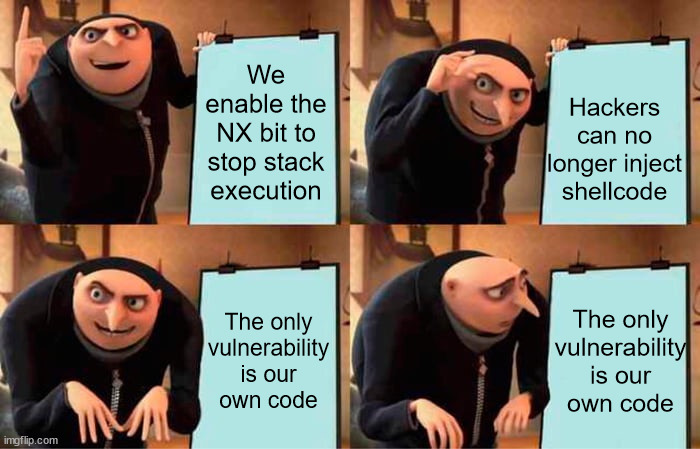Week 5
Return Oriented Programming
Good Faith Policy
“These courses expects a high standard of professionalism from its students with regard to how security testing is conducted. We expect all students to act in good faith at all times […]”
TL;DR Don’t be mean
Midsem Exam
Friday 2nd July (This week)
3 questions, 2 hours
10am - 6pm
Fuzzer Assignment
[WebCMS] -> [Course Work] -> [Major Project]
Key Dates
- Mid-point Submission - End of Week 7
- Final Submission - End of Week 10
Project Groups
- Submit groups on the form
- And also tell me / message me
ROP

ret instruction which already exist as executable code within each binary or library. These gadgets may be used for binary exploitation and to subvert vulnerable executables.When the addresses of many ROP Gadgets are written into a buffer we have formed a ROP Chain. If an attacker can move the stack pointer into this ROP Chain then control can be completely transferred to the attacker.
Most executables contain enough gadgets to write a turing-complete ROP Chain. For those that don’t, one can always use dynamic libraries contained in the same address-space (such as libc) once we know their addresses.
The beauty of using ROP Gadgets is that no new executable code needs to be written anywhere - an attacker may achieve their objective using only the code that already exists in the program. Source: github.com/Ben-Lichtman/ropr
TL;DR
- Instructions are multi-byte
- Bytes inside an instruction could form another instruction…
- We call these unintended instructions ‘gadgets’
- A ROP Chain is a series of ROP gadgets
- These gadgets are executable (circumvent NX) because they exist in the actual program code
What, how, I’m confused
Hi confused! I’m a diagram
0xFFFF +-----------+
| |
| |
| |
| |
| |
| |
|== RET ==|
| | \
| | |
| | | Current function
Start of ----> | | |
buffer | | /
0x0000 +-----------+
Tools of the trade
Which Gadget?
Ultimately we want to use gadgets that form some desired shellcode e.g. call to /bin/sh
execve("/bin/sh", NULL, NULL)
eax = 0xb (execve syscall) # mov eax, 0xb
ebx = bin_sh_address # ...
ecx = 0 # xor ecx, ecx
edx = 0 # xor edx, edx
syscall # int 0x80
Useful Gadgets
inc ...mov ...add ...sub ...pop ...
Using pop
Your ROP exploit doesn’t need to comprised of just addresses. We can pass values (NB: encoded correctly) and pop them off!
i.e. Set EAX to 13
gdgt{mov eax, 13}gdgt{xor eax, eax} + gdgt{inc eax}…gdgt{pop eax} + p32(0xd)
pop ...+ value
... |
payload += gdgt{pop ebx; ret;} |
payload += p32(0xAABBCCDD) | payload += ...
... | ...
# ebx = 0xAABBCCDD | #
Also don’t forget push esp
If you need to get the address of the stack position… find a gadget that pushes esp, and pops it
push esp; pop ...
Note: Generally both of these instructions need to be in the same gadget
ROP Gadgets + Functions
We can also add addresses in our ROP chain.
i.e found a call to
system? Use that!
- Consider the cdecl layout - last arguments first
- Consider the stack growth - function call first
payload += p32(0x804aabb) # some system() function address
payload += p32(addr_to_binsh)
0xFFFF +-----------------+
| | # esp+4 ^ when popped
| addr_to_binsh | # esp
| 0x804aabb | # esp-4 v when pushed
| ^-------- buffer start
0x0000 +-----------------+
What if a program doesn’t have enough gadgets?
A:
Find a better program
Use gadgets in dependent libraries
A: Uninstall, give up, cry, sleep
ret2libc
libc provides functions used by most programs!
i.e basically literally any C function
puts, printf, gets, etc…
Recipe
- Find a base address
- Find the
libcversion - Find a target address
pwntools
You can set the base address of an ELF in pwntools!
<ELF>.address = base_address
libc = ELF("libc_version.so")
libc.address = printf_leak - l.symbols['printf']
...
payload += p32(l.symbols['system']) # Offset adjusted!
Note: Also works for the program base
Note
Don’t forget about ASLR / PIE
- We need to leak the address of each needed library.
- library != segment
- Program base may need to also be leaked.
Dates
- Friday 2nd July (this week) - Midsem
- Monday, Week 7 - Wargames 5 Due
- End of Week 7 - Mid-point Fuzzer Due
- End of week 10 - Final Fuzzer Due
Activities
roproproproproproproprop